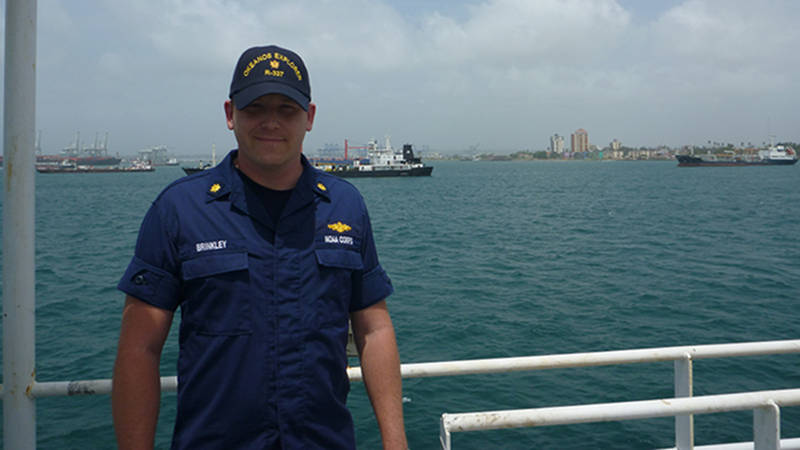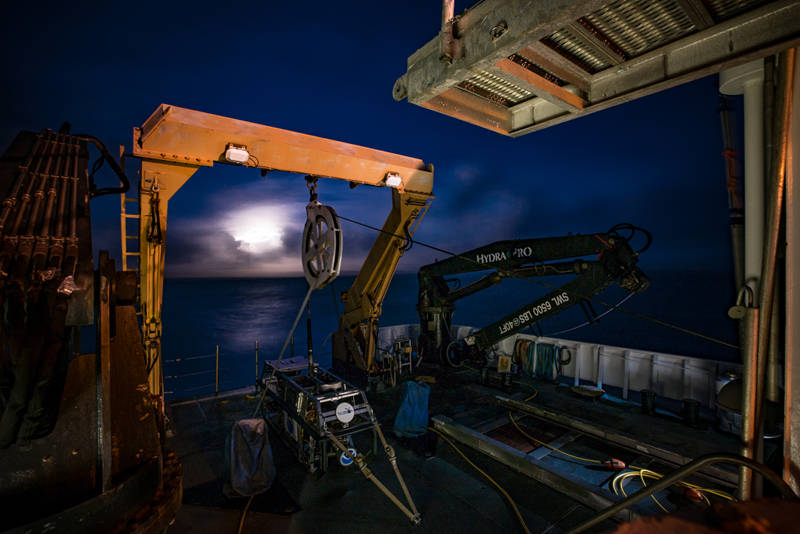
By Lieutenant Commander James Brinkley - Executive Officer, NOAA Ship Okeanos Explorer, University of Louisiana at Lafayette
September 26, 2015

Lieutenant Commander James Brinkley on the deck of NOAA Ship Okeanos Explorer. Image courtesy of the NOAA Office of Ocean Exploration and Research, 2015 Hohonu Moana. Download larger version (jpg, 4.0 MB).
NOAA vessels are a unique platform for ocean exploration. As they operate around the globe, collecting critical data about the world’s oceans and the ever-changing climate, they are often the most visible manifestation of America’s environmental intelligence, stewardship, and scientific community. The multi-million dollar fleet and its complement of crew of more than 500 sailors and officers reflect a large investment of our commitment to better understanding the ocean.

Moonrise over the fantail of Okeanos Explorer. Image courtesy of the NOAA Office of Ocean Exploration and Research, 2015 Hohonu Moana. Download larger version (jpg, 8.4 MB).
Officers given the responsibility for that investment are carefully selected. There are many times in a 24-hour day when an Executive Officer’s training, skill, and judgment are fundamental in safely and effectively conducting a ship's mission and successfully reaching the nation’s goals. In recognition for a singular role as the Executive Officer, the crew refers to him or her simply as “the XO.” There may be other officers on the ship of a similar grade, perhaps a medical officer, but there is no ambiguity when a crewmember refers to “the XO.” The respect between the XO and their crew is mutual.
My experience with NOAA ships goes back to 2005, beginning on the Ronald H. Brown (R-104), a baron of the AGOR class that had been in service since 1997. I was a young junior officer and served in a myriad of collateral duties, sailed between two oceans, and visited three continents all over a span of 25 months. I’ve done subsequent tours in the Washington, DC area and Charleston, South Carolina and forecasted tropical weather out of the National Hurricane Center in Miami, Florida.
A convenient way to begin answering “what’s a typical day like?” for an XO might be to start with some background information about NOAA ship Executive Officers. They represent the senior echelon among mid-grade officers with about 10 to 15 years of experience. They will have served multiple tours on any number of varying classed vessels with a variety of missions and requirements, but they all share the same responsibilities – serve as second in command; act as the direct representative of the Commanding Officer (CO); and remain accountable for all matters pertaining to management, safety, operations, and physical condition of the ship.
Crew and scientists on NOAA oceanographic research vessels never sleep, and therefore their executive officers seldom do either. Important activities go on all day and night. Mission planning, safely navigating the ship, mapping operations, preparing food, training and performing maintenance on important ship systems around the clock – the list is never ending. Much of the time, the XO can be found in his or her office responding to emails from around the fleet and keeping in close contact with their respective Marine Operations Center, sometimes six time zones away.
My morning usually starts at 0615. I shower, shave, pull out a fresh uniform, and walk about 15 steps next door to my office where I will review anywhere from 15 to 30 emails that came in overnight. I’ll spend approximately 30 minutes answering the most important of those emails before making my way down two flights of stairs to the mess deck for breakfast.
By 0715, with food in hand, I make a point of visiting with the Stewards, thanking them for preparing a quality meal for our crew and visiting scientists and to ask if there are any ongoing issues that need to be addressed. Usually nothing is mentioned, but on rare occasions there are questions that arise and it becomes my job to get them answered.
On the way out the door, after taking a few minutes to scarf breakfast, I meet with the Chief Boatswain and discuss safety and personnel issues or trade a causal conversation.
By 0755, the morning safety meeting is being announced on the public address system and by 0800, I will be on the bridge to contribute to a roundtable-like discussion on the key operations planned and any safety concerns.
The safety meeting ususally concludes around 0830 and then I meet privately with the CO for a few minutes and receive any instructions from him on assignments that need to be completed before the end of the day. By 0830, I’m back at my desk tending to the remaining emails that failed to get replied to earlier that morning. It’s common to have received 10 more in my inbox in the 45 minutes or so since I was last at my desk. I spend the next two hours addressing any number of administrative items ranging from submitting time sheets, accident reports, evaluations, audits, and augmenter support requests or replying to emails.
By 1000, I’ll take a break, get changed, and make my way down to the gym to run my usual four miles on the treadmill in the gym. By 1100, the smell of lunch will drift down the passageway and I go back to my room to shower, get changed, and then head back downstairs for lunch.
By 1145, I usually finish lunch and go back to my office one last time to ensure no last-minute shore-side communication has found its way into my inbox. I’ll take a few minutes of final solitude and report to the bridge by 1230 to relieve the off-going watch stander. For the next four hours, I serve as a bridge deck officer in any number of capacities such as a helmsman, navigator, lookout, and conning officer. During watch, I have an additional watch stander with me to assist in the lookout duties and sometimes a junior officer, who I mentor and help teach the safe practices of ship operations.
Today, the remotely operated vehicle (ROV) is in the water two miles below the surface in the Pacific waters off Johnston Atoll, and it’s my responsibility to safely maneuver the 224-foot, 2,062-ton Okeanos Explorer into position.
With cable drawn out over the side of the ship, I will spend the four hours of my bridge watch making finite adjustments in the movement of the ship in consultation with the ROV navigator. During that time, I’ll monitor the ships systems, take an hourly fix of the ship's position and plot it on the chart, collect hourly weather information for record, and maintain communication through radio with the ongoing deck and engineering operations throughout various locations on the ship.
By 1620, my relief has reported to the bridge and I begin a thorough pass down of the ship’s status, its systems, and any faults that may hamper safety of operations. By 1630, I’ve signed off in the deck log, a detailed account of my watch, and retired to my office to check email. By now it’s well into the evening hours on the East Coast and the West Coast will be seeing twilight. Email traffic has stopped but there is still plenty of work to be done.
By 1700, dinner lines are already beginning to form in the mess deck and I’ll make my way down to the mess deck to join everyone. Often, seating is limited so I make usually head to the lounge or library and socialize with other officers or sit with crew. Conversation is usually light as there is frequently a movie playing which garners everyone’s attention.
By 1725, my plate is scraped and I’m back at my office laying out an agenda for tomorrow’s projects and ensuring that the assignments given by the CO are completed. Depending on the task, this could take anywhere from several minutes to hours.
By 1830 and with normal work hours coming to an end, I’ll take personal time for myself and write friends and family, maybe watch a movie, and turn in by 2100 on a quiet day. Sometimes though, I end up working past 2230 if there is something that still needs to be handled.
The romanticism of going to sea has long been written about, but the reality less often described. It’s a hard life and I’ve seen many officers and crew members come and go. It takes a special breed of individual to successfully navigate the daily grind aboard a NOAA ship, but the reward is immense. You stand on the front lines of exploration and work among some of the most prestigious names in any number of scientific fields.
While being an XO is a physically demanding job, requiring broad seamanship experience, several qualifying duty assignments, and specialized training, it remains one of the most challenging and rewarding jobs in NOAA. On any given day, only 16 officers have that responsibilities and comradery among the few is plentiful.